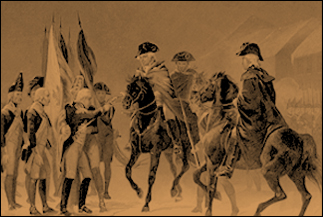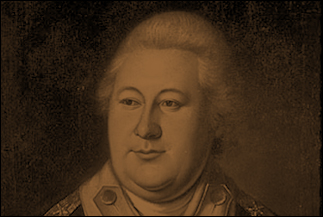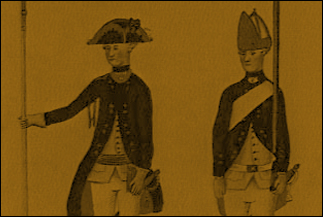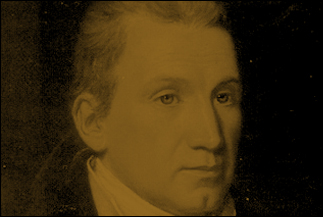The 1st Battle of Trenton, Hessian Resistance Collapse
The Hessians in the field attempted to reorganize, and make one last attempt to retake the town so they could make a breakout. Rall decided to attack the American flank on the heights north of the town. Rall yelled "Forward! Advance! Advance!", and the Hessians began to move.
Washington, who was still on the high ground, saw the Hessians approaching the American flank and moved his troops so they could be in battle formation where the Hessians approached. The two Hessian Regiments began marching toward King Street, but were caught in American fire that came at them in three directions. Some Americans had taken up positions inside houses, making it difficult to be hit. Even some civilians joined the fight against the Hessians.
 Colonel Johann Ralls Surrender
Colonel Johann Ralls Surrender
 Henry Knox
Henry Knox
 Knyphausen Regiment uniforms
Knyphausen Regiment uniforms
 Lieutenant James Monroe
Lieutenant James Monroe
Despite this, they continued to push, recapturing their cannon. Knox, at the head of King Street, saw that the Hessians had retaken the cannon and ordered that they be taken. Six men ran, and after a brief struggle, seized the cannon, turning it on the Hessians. Most of the Hessians were unable to fire their guns and the attack stalled. The Hessians formations broke, and they began to scatter. At this point, Rall was mortally wounded. Washington came down from the high ground, and led his troops yelling "March on, my brave fellows, after me!" Most of the Hessians retreated into an Orchard, with the Americans in close pursuit, and they quickly surrounded them. A German-speaking American offered the Hessians surrender terms, and they agreed.
The remains of the Knyphausen Regiment had been ordered to join Rall, but due to a misunderstanding, they marched in the opposite direction. They tried to escape across the bridge, but found it had been taken. The Americans quickly swept in, and a Hessian attempt to break through their lines failed. They were cut off from the bridge, surrounded by Sullivan's men and forced to surrender.
Casualties
The Hessian forces suffered 22 killed, 83 seriously wounded and 896 captured. The Americans suffered only two killed and five wounded, although their casualties may have been heavier than the Hessians if the soldiers who died of exhaustion, exposure, and illness the following days are included. The captured Hessians were sent to Philadelphia and later Lancaster, only to be moved once again in 1777, this time to Virginia. Rall was mortally wounded and died later that day at his headquarters. All four Hessian colonels in Trenton were killed in the battle. The Lossberg regiment was effectively removed from the British forces. Parts of the Knyphausen regiment escaped to the south, but Sullivan captured some 200 men along with the regiment's cannons and supplies. Also captured were about 1,000 arms and some much-needed ammunition.
Myths
The Hessians were surprised and shocked by the sudden attack of the Americans, and it has commonly been believed that they were intoxicated from celebrating Christmas. Military Historian Edward G. Lengel said:
"there is no truth to the legend claiming that they were helplessly drunk."
Historian David Hackett Fischer said "It wasn't so," and points out that even an American Soldier, John Greenwood, who fought in the battle and looked after the Hessians after the battle said "I am certain not a drop of liquor was drunk during the whole night, nor, as I could see, even a piece of bread eaten."
Effects
Following the surrender of the Hessians, Washington is reported to have grabbed the hand of a young officer and said "This is a glorious day for our country." However, he soon learned that Cadwalader and Ewing had been unable to make the crossing, leaving his worn-out army of 2,400 men alone. Without their 2,600 men, Washington realized that he would not be able to push onto Princeton and New Brunswick at that time.
This small but decisive battle, as with the much later Battle of Cowpens, had an effect disproportionate to its size. The colonial effort across the colonies was galvanized and the psychological dominance achieved by the British Government troops in the previous months overturned. Howe was stunned that such a substantial Hessian garrison could be surprised and overwhelmed so easily, without putting up much resistance. However, Fischer argues this was more due to the efforts of Thomas Paine and the New Jersey Militia than it was to the battle itself.
Aftermath
Surrender of the Hessian Troops
By noon, Washington's force had moved to re-cross the Delaware back into Pennsylvania, taking their prisoners and captured supplies with them. This battle gave the Continental Congress a new confidence because it proved Colonial forces could defeat regulars. It also increased the re-enlistments in the Continental Army forces. The colonials had now proved themselves against a European army and the fear the Hessians inspired earlier that year in New York was broken.
Two notable officers were wounded, William Washington, cousin of the General, who was badly wounded in both hands, and Lieutenant James Monroe, the future President of the United States. Monroe was carried from the field bleeding badly after he was struck in the left shoulder by a musket ball, which severed an artery. Doctor John Riker clamped the artery, keeping him from bleeding to death.
Legacy
The hours before the battle served as the inspiration for the painting Washington Crossing the Delaware by German American artist Emanuel Leutze. The image in the painting, in which Washington stands majestic in his boat as it is crossing the Delaware River, is believed by some, to be more symbolic than historically accurate, because the waters of the river were icy and treacherous, and the flag Monroe holds was not created until six months after the battle. In addition, contrary to the painting, the crossing occurred before dawn. Fischer argues that since the crossing took place in a storm, anyone who sat down in the boats would have been sitting in ice water and thus they would have stood. Nonetheless, the image has become an icon of American history.
The Trenton Battle Monument erected at "Five Points" stands as a tribute to this crucial American victory. The crossing and battle is reenacted every year.
PREVIOUS: The 1st Battle of Trenton Pt.I | The 1st Battle of Trenton Pt.II | NEXT: The 2nd Battle of Trenton




